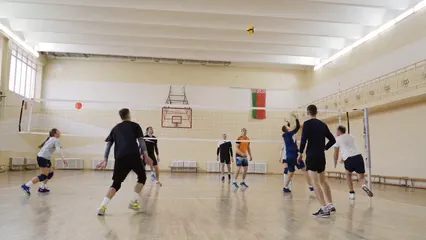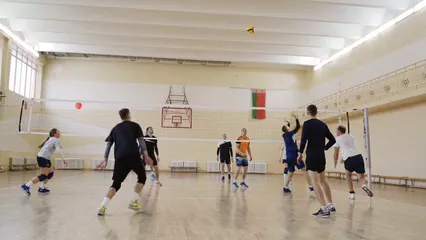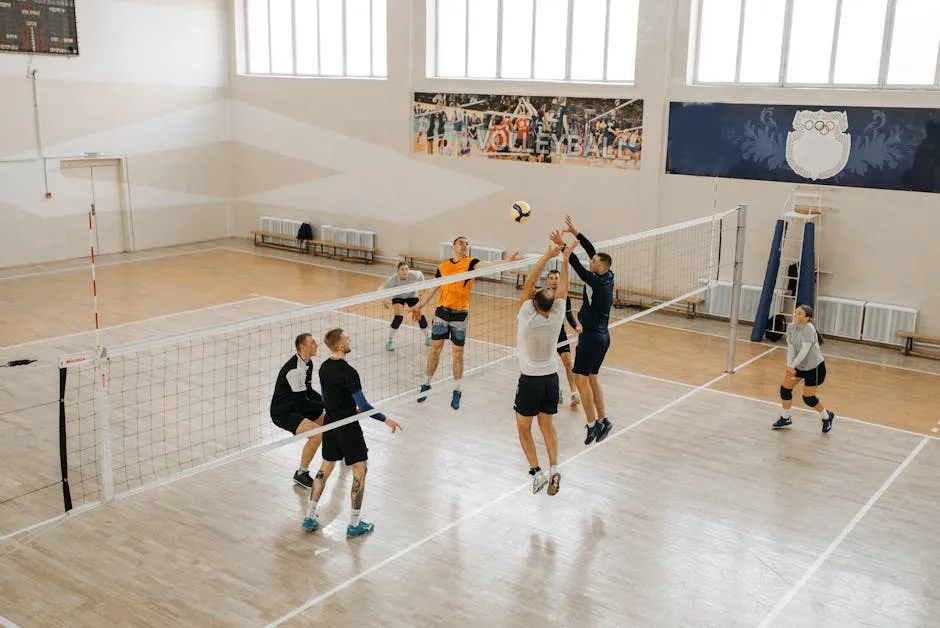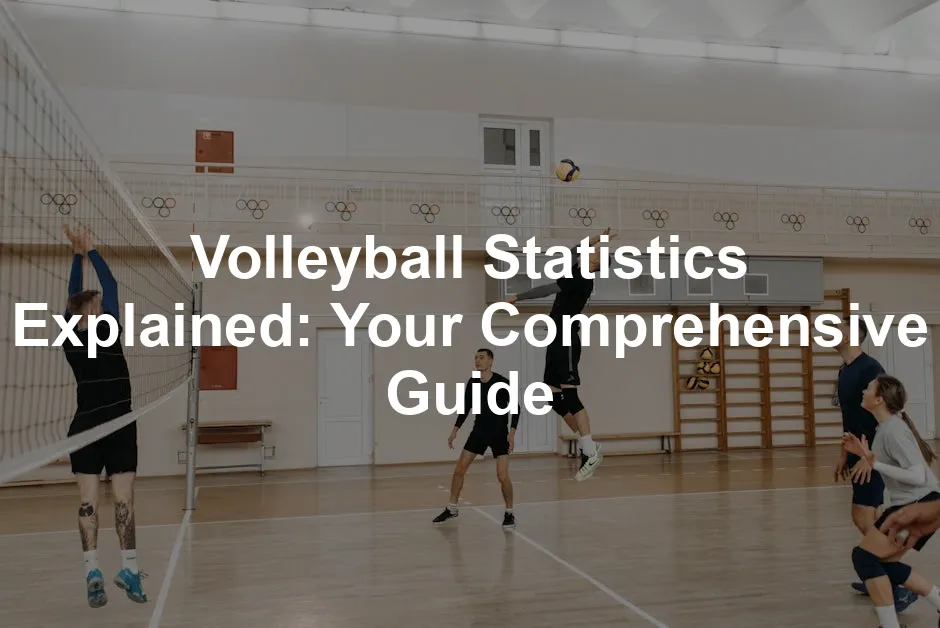Introduction
Statistics in volleyball are like secret sauce—they spice up the game! They help players, coaches, and fans grasp performance nuances. Picture this: a player spikes the ball, and that single action can tell a story through numbers. Stats are essential for understanding who’s on fire and who needs a motivational pep talk.
Historically, volleyball stats started as simple tallies—like counting points or errors. Fast forward to today, and we have advanced analytics that would make a mathematician blush. Teams now analyze everything from serve efficiency to a player’s perfect reception percentage. It’s like playing chess, but with a beach ball!
The purpose of this article? We’re here to demystify volleyball statistics and highlight key metrics that can elevate your game. Whether you’re a coach looking to refine strategies or a fan wanting to impress your friends, we’ve got you covered. Let’s jump into the fascinating world of volleyball stats!

Understanding Volleyball Statistics
What Are Volleyball Statistics?
Volleyball statistics are numerical representations of player and team performance. They give insights into how well a player or team executes their strategies. These stats are crucial for analyzing strengths, weaknesses, and overall game effectiveness.
The stats can vary dramatically depending on the level of play. For example, professional leagues often track advanced metrics, while amateur leagues may focus on basic numbers. Understanding these differences is key to appreciating the game at various levels.
Common statistics include:
- Total Points: Sum of points scored through kills, blocks, and aces.
- Attack Efficiency: A way to measure how effective a player is when attacking.
- Serving Percentage: Indicates how often serves are successfully executed.
- Reception Errors: Tracks how often passes go awry.
Incorporating these metrics into analysis can significantly improve a player’s understanding of their performance. Imagine a player learning they consistently hit the ball out of bounds. With that knowledge, they can adjust their approach, ultimately leading to better outcomes during games.
As volleyball evolves, so too does the complexity of statistics. With more teams adopting advanced analytics, understanding these metrics can help players and coaches make informed decisions. So, whether you’re on the court or cheering from the sidelines, mastering volleyball statistics can enhance your overall experience of the game.

Speaking of enhancing your game, check out Volleyball Training: The Complete Guide. This book is a treasure trove of drills and strategies that can take your skills to the next level!
The Importance of Statistics in Volleyball
Statistics play a pivotal role in volleyball. They enhance player development and refine team strategies. Coaches rely on data to make informed decisions. This data-driven approach can transform a struggling player into a star. Imagine a coach using stats to pinpoint a player’s weaknesses. With targeted training, that player can improve and contribute more effectively to the team.
Statistics also help in player recruitment. Scouts analyze data to identify talent. A player’s performance metrics can reveal their potential. For example, a high kill percentage or low error rate can showcase a player’s effectiveness. Teams looking to build championship rosters often prioritize players with strong statistical backgrounds.
Successful teams like the USA Women’s National Team have embraced analytics. They utilize stats to assess performance and adjust strategies. Similarly, clubs across various leagues track metrics to gain a competitive edge. In today’s game, ignoring stats is like playing volleyball with one hand tied behind your back.

If you want to dive deeper into volleyball coaching, I recommend The Volleyball Coaching Bible. This book is packed with insights that can help you lead your team to victory!
Key Volleyball Statistics
Points and Scoring Metrics
Total Points Scored
Total points scored is the heartbeat of volleyball statistics. It sums up three critical components: Aces, Kills, and Blocks. An ace is a serve that directly results in a point. Kills occur when an attacking play results in a point. Blocks are defensive maneuvers that also score points.
By calculating total points scored, you can assess a player’s impact on the game. A player who consistently contributes to total points is invaluable. Coaches can use this data to identify key players during crucial matches.
Tracking total points helps teams understand which players excel in pressure situations. It’s a straightforward stat that speaks volumes about performance.

Break Points and Balance
Now, let’s tackle Break Points (BP) and Balance (Bal). Break Points refer to the total points scored while your team is serving. It’s a critical metric. High performance in this area indicates that a team can capitalize on their serve.
Balance, on the other hand, reflects overall performance. It’s calculated by subtracting total errors from total points. A higher Balance score means fewer mistakes, which is essential for winning matches.
Evaluating BP and Bal helps coaches understand a player’s performance during pivotal moments. If a player consistently scores during Break Points, they’re likely clutch. Such stats provide insight into how players handle pressure, crucial for success in any match.

Serving Statistics
Serve Attempts, Errors, and Aces
Serving statistics pack a punch! They reveal a player’s ability to set the tone for the match. Serve attempts are simply the number of times a player tries to serve the ball. Errors occur when the serve fails to make it over the net or lands out of bounds. Service aces? They’re the sweet victory of a serve that the opponent can’t handle.
When analyzing these stats, efficiency shines. A high ace-to-error ratio means a player is serving effectively. Coaches love this because it directly impacts game outcomes. A team with a strong serving performance can dominate the scoreboard. Conversely, frequent errors can shift momentum to the opponent. Knowing this, players should strive to improve their serving game. Practice makes perfect, and a solid serve can turn a match around!

To improve your serving, consider investing in Volleyball Essentials: The Skills and Strategy. This book offers practical techniques to elevate your serving game!
Serving Efficiency
Calculating serving efficiency is crucial for understanding match performance. It’s done by this formula: (Total Good Serves – Errors) divided by Total Serve Attempts. This tells us how many serves successfully disrupted the opponent’s play.
Efficiency matters! High-efficiency servers can boost their team’s chances of winning. For example, a player with a 95% efficiency means they rarely miss their serves. Imagine the confidence that brings! Coaches can spotlight these players, placing them in critical moments.
Some legendary servers, like Karch Kiraly, had stellar serving efficiency throughout their careers. Their ability to pressure opponents with each serve made them icons of the sport. So, tracking serving efficiency isn’t just a number—it’s a game-changer!
Reception Statistics
Reception Attempts and Errors
Reception attempts and errors are vital metrics for team performance. Reception attempts refer to how many times a player tries to pass a serve from the opponent. Errors happen when these passes fail, leading to lost points.
These stats are critical for assessing how well a team handles serves. A high number of errors signals trouble. Teams must assess their reception quality using a rating scale from 1 to 4. A score of 4 means a perfect pass, while 1 indicates a poor attempt.
Good reception lays the foundation for a successful play. When players can receive serves effectively, setters can work their magic. This synergy is essential for scoring points and winning matches!
To help with your reception skills, try using Kinesiology Tape for Sports. It can help with muscle support during those intense games!
Perfect Reception Percentage
Perfect reception percentage is another key metric. It calculates the percentage of receptions that are rated as perfect (4s). This stat gives insight into a team’s consistency in handling opponents’ serves. A high perfect reception percentage allows setters to execute diverse plays.
Teams should aim for a high percentage. This enables them to maintain offensive pressure. After all, a strong reception game can make all the difference in a tight match. So, keep an eye on those reception stats—they’re more than just numbers; they’re the pulse of the game!

Attacking Performance
Spike Metrics
In volleyball, spikes are a player’s best friend. A spike occurs when a player attacks the ball with the intent to score. To truly understand attacking performance, we need to look at several key metrics: total attack attempts, errors, and block counts.
Total attack attempts are the total number of spikes a player makes during a match. Errors occur when a spike fails to result in a point—think hitting the ball out of bounds or into the net. Block counts track how many of a player’s attacks were successfully blocked by the opposing team.
Now, let’s talk about kill percentage and attack efficiency. Kill percentage is calculated by dividing the total number of kills by the total attack attempts. This stat reflects a player’s effectiveness in scoring. Attack efficiency, on the other hand, is a more nuanced measure. It’s calculated by taking the total kills, subtracting errors and blocked attempts, and dividing by total attempts. High efficiency means a player is scoring more points with fewer mistakes.
These spike metrics are essential for any offensive strategy. They help coaches identify strengths and weaknesses, allowing teams to adapt and overcome during matches.

If you’re looking to boost your attacking game, consider checking out The Art of Coaching Volleyball: A Comprehensive Guide. It’s filled with tips and techniques that can elevate your game!
Kill Percentage and Efficiency
Kill percentage and efficiency are vital for understanding a player’s impact on the game. To calculate kill percentage, simply divide the total number of kills by total attack attempts and multiply by 100. This tells you what percentage of a player’s spikes resulted in points. High kill percentages indicate that a player is a reliable scoring threat.
Now, let’s break down efficiency. The formula for attack efficiency is (kills – errors – blocks) divided by total attempts. This stat looks beyond just scoring; it assesses how effectively a player contributes to the team’s offense.
High kill percentages and attack efficiency are essential for developing effective offensive strategies. Coaches can use these metrics to analyze matchups and find the best ways to exploit the opponent’s weaknesses. A player with a high kill percentage can be a focal point of an attack, while those with high efficiency can balance the offense, ensuring the team remains competitive.

Blocking Metrics
Block Counts
Block counts are crucial in volleyball defense. They track how many times a player successfully blocks an opponent’s spike. There are two types of blocks to consider: solo blocks and team blocks. A solo block occurs when one player stops an attack alone. Team blocks happen when two or more players work together to thwart an opponent’s spike.
Why are block counts significant? Effective blocking can shift the momentum of a match. A well-timed block not only prevents a point but also energizes the team. It can demoralize the opposing attackers and lead to errors on their part.
In tight matches, the ability to block effectively can be the difference between winning and losing. Coaches pay close attention to block counts, as they can provide insight into a team’s defensive capabilities. A strong blocking performance can turn the tide, giving a team the upper hand and a chance to capitalize on the situation.

To support your blocking skills, check out The Volleyball Drill Book. It provides exercises specifically designed to enhance your blocking technique!
Assists and Sets Played
Understanding Assists
In volleyball, assists are a big deal! An assist occurs when a player sets the ball to a teammate, who then scores a kill. This stat shines a light on the setter’s skill and the team’s chemistry. A high number of assists usually indicates smooth teamwork. It shows that players are working together like a well-oiled machine!
Measuring assists is crucial for evaluating both setters and overall team dynamics. If a setter dishes out a lot of assists, that’s a good sign! It means they’re not just setting the ball; they’re creating opportunities for teammates to shine. In performance metrics, assists are essential. They help gauge how effective a team is at converting plays into points.
When analyzing a match, look closely at assists. A team with more assists often wins. This stat reflects the ability to work together and capitalize on each player’s strengths. So, next time you watch a game, pay attention to assists. They tell a story of collaboration and skill!

If you want to enhance your setting skills, consider The Complete Handbook of Coaching Volleyball. This resource offers strategies and tips that can help you excel as a setter!
Sets Played
Sets played are another critical statistic in volleyball. Each set in a match goes to 25 points, and tracking how many sets a player participates in is vital for assessing performance fairly. Why is that? If one player has a ton of digs but only played a couple of sets, their impact can be misleading.
When comparing players, consider the number of sets played. For example, if two liberos each have 40 digs, but one played in four sets and the other in eight, it’s clear who’s the more effective player. The one averaging 10 digs per set is doing a better job!
Sets played help create a level playing field for performance evaluation. They provide context for other statistics, making them much more meaningful. So, don’t overlook this metric! It’s essential for understanding a player’s contributions and overall effectiveness in a match.

For a deeper dive into volleyball statistics, check out this comprehensive guide on volleyball statistics.
And don’t forget to hydrate! A Hydro Flask Water Bottle keeps your drinks cold during those intense matches!
Please let us know what you think about our content by leaving a comment down below!
Thank you for reading till here 🙂
All images from Pexels




